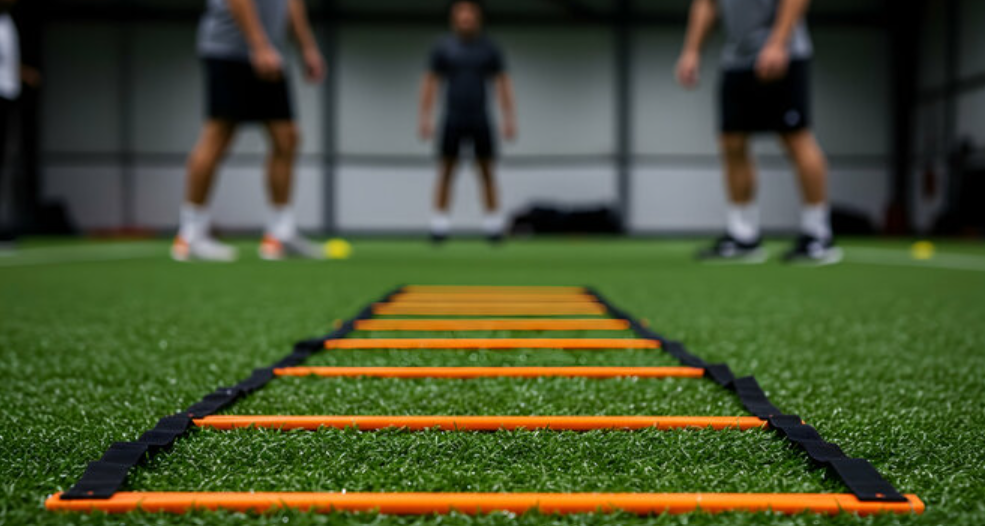SPEED AND AGILITY DRILLS FOR ATHLETIC PERFORMANCE
fitness Mindset Aug 10, 2025 6:22:19 PM Kyle Receno 8 min read

Speed and agility are critical components of athletic performance, enabling athletes to move quickly, change direction efficiently, and react swiftly in sports like soccer, basketball, or track. Targeted drills can enhance these skills by improving neuromuscular coordination, power, and reaction time. This blog explores the science behind speed and agility training, its benefits, and a practical routine to boost athletic performance.
Why Speed and Agility Matter
Speed is the ability to move quickly in a straight line, while agility involves rapid directional changes with control. Both rely on fast-twitch muscle fibers, coordination, and efficient movement mechanics. Training these qualities enhances performance in competitive sports and reduces injury risk by improving body control.
Key Benefits:
- Faster Movement: Increases sprint speed and reaction time.
- Improved Agility: Enhances ability to pivot, dodge, or weave.
- Better Coordination: Sharpens neuromuscular response for precise movements.
- Injury Prevention: Strengthens stabilizing muscles and joints.
- Enhanced Athleticism: Boosts performance in sports requiring quick, dynamic actions.
Principles of Speed and Agility Training
Effective training emphasizes explosive movements, proper technique, and recovery. Key principles include:
- Maximal Intent: Perform drills at high intensity to mimic game conditions.
- Quality Over Quantity: Focus on precise, controlled reps rather than volume.
- Progressive Overload: Gradually increase intensity or complexity as skills improve.
- Recovery: Allow 48–72 hours between sessions to prevent overtraining.
- Specificity: Tailor drills to sport-specific movements (e.g., lateral cuts for basketball).
Top Speed and Agility Drills
Below are effective drills to enhance speed and agility. Perform these 2–3 times per week on a soft surface (e.g., grass or track) with proper footwear. Warm up thoroughly to prevent injury.
1. Sprint Intervals
Purpose: Builds linear speed and explosive power.
- How to Perform: Sprint at maximum effort for 20–30 meters, then walk back to recover. Focus on driving knees and pumping arms.
- Reps/Sets: 6–8 sprints, 1–2 minutes rest between each.
- Tip: Keep strides smooth and avoid overstriding.
2. Agility Ladder (In-and-Out Drill)
Purpose: Improves foot speed and coordination.
- How to Perform: Using an agility ladder, step both feet in and out of each square quickly, moving forward. Keep knees slightly bent and stay on the balls of your feet.
- Reps/Sets: 6–8 passes through the ladder, 3 sets, 30 seconds rest between sets.
- Tip: Start slow to master footwork, then increase speed.
3. Lateral Shuffle
Purpose: Enhances side-to-side agility for sports like soccer or tennis.
- How to Perform: Start in an athletic stance, shuffle laterally for 10 meters, keeping hips low and feet apart. Switch directions without crossing feet.
- Reps/Sets: 4–6 shuffles per side, 3 sets, 30–60 seconds rest.
- Tip: Stay low and avoid bouncing to maintain control.
4. T-Drill
Purpose: Develops multidirectional agility and quick transitions.
- How to Perform: Set up cones in a T shape (10 meters forward, 5 meters side-to-side). Sprint forward to the top cone, shuffle left, shuffle right, backpedal to start.
- Reps/Sets: 6–8 reps, 3 sets, 60 seconds rest.
- Tip: Keep movements sharp and plant feet firmly at turns.
5. Bounding
Purpose: Increases stride length and explosive power for speed.
- How to Perform: Leap forward with exaggerated strides, pushing off one leg and landing on the other. Focus on height and distance, using arms for momentum.
- Reps/Sets: 3 sets of 20–30 meters, 60 seconds rest.
- Tip: Land softly to protect joints and maintain balance.
Sample Speed and Agility Workout (20–25 Minutes)
Incorporate this routine into your training to boost athletic performance:
- Warm-Up (5–7 Minutes): Dynamic stretches (e.g., high knees, leg swings) and light jogging to prepare muscles.
- Sprint Intervals: 6 sprints of 20 meters, 1-minute rest between each.
- Agility Ladder (In-and-Out): 6 passes, 3 sets, 30 seconds rest.
- Lateral Shuffle: 4 shuffles per side, 3 sets, 30 seconds rest.
- T-Drill: 6 reps, 2 sets, 60 seconds rest.
- Bounding: 3 sets of 20 meters, 60 seconds rest.
- Cool-Down (5 Minutes): Static stretches for quads, hamstrings, and calves.
Tips for Success
- Focus on Form: Prioritize technique to maximize efficiency and prevent injury.
- Progress Gradually: Start with fewer reps or simpler drills and increase intensity over time.
- Rest Adequately: Take 48–72 hours between sessions to allow muscle recovery.
- Use Proper Equipment: Wear supportive shoes and train on a soft surface to reduce impact.
- Combine with Strength Training: Pair with squats or deadlifts to build power.
Common Mistakes to Avoid
- Poor Technique: Overstriding or sloppy footwork reduces effectiveness and risks injury.
- Skipping Warm-Ups: Cold muscles are prone to strains; always warm up thoroughly.
- Overtraining: Too many sessions without rest leads to fatigue or burnout.
- Ignoring Recovery: Inadequate nutrition or sleep slows progress and increases injury risk.
Who Can Benefit?
Speed and agility drills are ideal for:
- Athletes: Soccer, basketball, or track athletes needing quick movements.
- Fitness Enthusiasts: Those aiming to improve dynamic performance.
- Recreational Sports: Enhances skills for casual games or activities.
- Injury Recovery: Supports rehabilitation with professional guidance.
Additional Considerations
- Nutrition: Consume 1.6–2.2g protein/kg and 4–6g carbs/kg daily to support muscle repair and energy.
- Hydration: Drink 0.7–1 oz water/kg body weight daily, plus extra during training.
- Mobility Work: Include stretching or foam rolling to maintain flexibility and joint health.
Conclusion
Speed and agility drills like sprint intervals, agility ladder work, and T-drills are powerful tools to enhance athletic performance. By incorporating these exercises into your routine with proper form and recovery, you can boost speed, coordination, and resilience. Start with the sample workout and consult a coach for personalized guidance.
Disclaimer: Consult a fitness professional before starting speed and agility training, especially if you have injuries or medical conditions.
